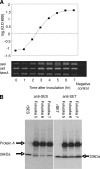Identification and characterization of two novel staphylococcal enterotoxins, types S and T
- PMID: 18710864
- PMCID: PMC2573384
- DOI: 10.1128/IAI.00045-08
Identification and characterization of two novel staphylococcal enterotoxins, types S and T
Abstract
In addition to two known staphylococcal enterotoxin-like genes (selj and selr), two novel genes coding for two superantigens, staphylococcal enterotoxins S and T (SES and SET), were identified in plasmid pF5, which is harbored by food poisoning-related Staphylococcus aureus strain Fukuoka 5. This strain was implicated in a food poisoning incident in Fukuoka City, Japan, in 1997. Recombinant SES (rSES) specifically stimulated human T cells in a T-cell receptor Vbeta9- and Vbeta16-specific manner in the presence of major histocompatibility complex (MHC) class II(+) antigen-presenting cells (APC). rSET also stimulated T cells in the presence of MHC class II(+) APC, although its Vbeta skewing was not found in reactive T cells. Subsequently, we examined the emetic activity of SES and SET. We also studied SElR to determine emetic activity in primates. This toxin was identified in previous studies but was not examined in terms of possession of emetic activity for primates. rSES induced emetic reactions in two of four monkeys at a dose of 100 microg/kg within 5 h of intragastric administration. In one monkey, rSET induced a delayed reaction (24 h postadministration) at a dose of 100 microg/kg, and in the other one, the reaction occurred 5 days postadministration. rSElR induced a reaction in two of six animals within 5 h at 100 microg/kg. On this basis, we speculate that the causative toxins of vomiting in the Fukuoka case are SES and SER. Additionally, SES, SER, and SET also induced emesis in house musk shrews as in the monkeys.
Figures





References
-
- Arcus, V. L., R. Langley, T. Proft, J. D. Fraser, and E. N. Baker. 2002. The three-dimensional structure of a superantigen-like protein, SET3, from a pathogenicity island of the Staphylococcus aureus genome. J. Biol. Chem. 27732274-32281. - PubMed
-
- Baba, T., F. Takeuchi, M. Kuroda, H. Yuzawa, K. Aoki, A. Oguchi, Y. Nagai, N. Iwama, K. Asano, T. Naimi, H. Kuroda, L. Cui, K. Yamamoto, and K. Hiramatsu. 2002. Genome and virulence determinants of high virulence community-acquired MRSA. Lancet 3591819-1827. - PubMed
-
- Bergdoll, M. S. 1988. Monkey feeding test for staphylococcal enterotoxin. Methods Enzymol. 165324-333. - PubMed
-
- Bergdoll, M. S. 1989. Staphylococcus aureus, p. 463-523. In M. P. Doyle (ed.), Foodborne bacterial pathogens. Marcel Dekker, Inc., New York, NY.
-
- Fueyo, J. M., M. C. Mendoza, and M. C. Martin. 2005. Enterotoxins and toxic shock syndrome toxin in Staphylococcus aureus recovered from human nasal carriers and manually handled foods: epidemiological and genetic findings. Microbes Infect. 7187-194. - PubMed
Publication types
MeSH terms
Substances
Associated data
- Actions
LinkOut - more resources
Full Text Sources
Other Literature Sources
Research Materials

